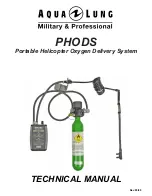
4
IM 701928-01E
Preparing for Measurement
CAUTION
When using a 701928/701929 current probe, it may not be possible to
use multiple active probes at the same time due to the current capacity
limitation of the YOKOGAWA probe interface of a waveform measuring
instrument. Make sure that the total current consumption of each active
probe does not exceed the current capacity. The current consumption of
the probe depends on the measured current.
See the following YOKOGAWA website for the usage limitations for each
measuring instrument.
https://tmi.yokogawa.com/solutions/products/oscilloscopes/current-probes/
1.
Set up the probe and a DLM series or another digital oscilloscope with
the YOKOGAWA probe interface.
2.
Before measurement, insert the probe interface completely into the
input of the oscilloscope and confirm that a secure connection has
been established between the BNC connector and interface pins. When
inserted, you will hear a click as the latch closes, indicating that the
connection has been made.
Warm Up
Immediately after connecting the probe, heat emitted from the probe itself
causes the output offset voltage to drift. After applying power, the probe should
nearly stabilize about 30 minutes after connecting it. Before using the probe,
allow it to warm up for at least 30 minutes.
Demagnetization and Zero Adjustment
CAUTION
• When removing the probe from the oscilloscope, be sure to release the
lock first, then pull out the probe by the connector. The probe interface
can be damaged if you pull forcibly without releasing the lock, or if you
pull by the cable.
• Do not demagnetize the probe while the clamp is positioned around
the conductor under measurement. The demagnetization procedure
can inject current into the conductor under measurement, possibly
resulting in damage to connected components. For the same reason,
make sure that the probe clamp is not positioned around a conductor
under measurement when connecting this probe to the oscilloscope. A
demagnetizing waveform can be generated when power is supplied.









































